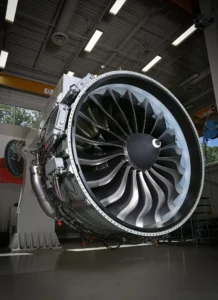Perhaps more than in any other industry apart from healthcare, safety, efficiency, accuracy and reliability are cornerstones of the aviation industry, and aircraft Maintenance, Repair, and Overhaul (MRO) operations form the backbone of aviation safety, ensuring that aircraft remain totally airworthy throughout their lifecycle. However, to operate effectively, MROs require a healthy supply chain that can provide the necessary tools, machinery, parts and documentation in a highly complex and data-driven environment where management of that data is key to smooth and safe operations. At the core of everything, data management is responsible for overseeing operational efficiency and ensuring compliance with stringent regulatory standards.
Understanding the MRO Supply Chain
For a number of reasons, the supply chain for the MRO sector is not like a ‘normal’ industrial supply chain. First there is a level of unpredictability with regard to demand for certain aircraft parts, plus there can be long lead times for those parts if they are new OEM (original equipment manufacturer) ones as opposed to USM (used serviceable material) parts. Beyond this, many aircraft and engine parts are highly specialised, and everything that is provided also comes with legally required and comprehensive documentation and traceability. As a consequence, this complexity demands precise coordination and effective information sharing among manufacturers, parts suppliers, logistics providers, maintenance crews, and regulatory bodies. In reality, data is the delicate thread that connects these stakeholders—providing real-time visibility, traceability, and control across the entire supply chain.
The Role of Data Management
Data management in the MRO supply chain refers to the systematic overseeing of data primarily related to inventories, parts tracking, maintenance history, logistics, supplier performance, compliance records, and more. Thus, in a perfect world, effective data management should result in the timely availability of parts, reduced costs, minimised downtime, and enhanced safety. So how can this be achieved? Let’s look at half a dozen of the principal elements of effective data management:
- Inventory optimisation: One of the greatest challenges facing an MRO operation is holding the optimum amount of inventory. The cost of aircraft parts is huge, yet not holding sufficient numbers or even lacking a vital part entirely could be costly for the business and the carrier. To optimise MRO inventory, effective data management can enable predictive analytics and demand forecasting, helping MRO providers to stock the right components at optimum levels. This is particularly crucial for high-cost, low-usage parts where excess inventory ties up both too much capital and shelf space.
- Real-time parts’ tracking: Withaircraft flying all over the world, MRO providers have to provide various parts on a global basis as despite scheduled maintenance that carefully takes into account the potential lifecycle of parts, parts can still fail unexpectedly. Consequently, parts can frequently travel across the globe at short notice for a repair or replacement. Failed parts can lead to an AOG situation (aircraft on the ground) which is costly for any carrier, so the more rapid the response to a needed part, the less the economic fallout. Data systems that offer real-time visibility into parts location, condition, and status help to ensure efficient logistics and reduce AOG time. This capability can also facilitate faster decision-making and coordination between depots, repair shops, and suppliers.
- Regulatory compliance and traceability: Aviation authorities such as the FAA (Federal Aviation Administration) and EASA (European Union Aviation Safety Agency) require strict adherence to maintenance procedures and documentation and that every part installed on an aircraft must have a traceable history. Data management systems can ensure that maintenance records, certifications, service bulletins, and airworthiness directives are properly documented, accessible, and compliant with all applicable regulations.
- Lifecycle management: Aircraft components often have finite lifespans measured in cycles, hours, or calendar days. As a consequence, managing the lifecycle of each part through digital systems helps considerably in the accurate prediction of maintenance needs, scheduling of preventive checks, and planning part replacements, consequently reducing unplanned downtime and extending asset life.
- Supplier performance monitoring: A supply chain is only as strong as the suppliers involved, so there is a need for data systems which can help evaluate supplier performance by tracking on-time delivery rates, quality metrics, and service responsiveness. As a result, this information can help foster better supplier management and sourcing decisions.
- Digital twin and predictive maintenance – The arrival of digital twins is proving to be something of a gamechanger in the MRO field, but these virtual replicas of physical systems rely extensively on robust data infrastructure. However, through combining sensor data with historical maintenance records, predictive maintenance models can foresee potential failures before they occur which, in turn, can reduce incidences of unscheduled repairs, cut maintenance costs, and enhance operational readiness.
Challenges faced in data management
While digitalisation has drastically changed the data management landscape, there is no escaping what is best referred to as legacy IT systems, data silos, inconsistent data standards, and cybersecurity threats, all of which are capable of hampering integration and collaboration. Beyond this comes the challenge of handling data that comes in various forms, from handwritten maintenance logs to sensor outputs—all of which require sophisticated tools and processes for effective management of the data involved. In addition, the implementation of centralised MRO platforms and enterprise resource planning (ERP) systems significantly helps to unify data across departments and locations, streamlining operations and providing a single source of facts.
In conclusion
Data management is as much a critical element of MRO operations as aircraft parts themselves. Effective data management can lead to the seamless operation of the MRO supply chain, ensuring that the right part reaches the right place at the right time, together with the necessary documentation and history. As the aviation industry further embraces digital technologies, investing in robust data management capabilities is not just advantageous, it is essential for increased safety, compliance, cost-efficiency, as well as future competitiveness.


































